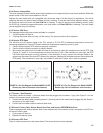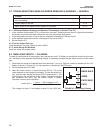
MODEL FCL-1056 SECTION 9.0
TROUBLESHOOTING
9.5.3 Sensor can be calibrated, but the current is too low
1. Is the temperature low or is the pH high? Sensor current is a strong function of pH and temperature. The
sensor current decreases about 3% for every °C drop in temperature. Sensor current also decreases as pH
increases. Above pH 7, a 0.1 unit increase in pH lowers the current about 5%.
2. Sensor current depends on the rate of sample flow past the sensor tip. If the flow is too low, chlorine readings
will be low. Verify that the chlorine sensor is installed in the correct flow cell. See Figure 2-1 and 2-2. Be sure
the liquid level in the constant head sampler is level with the central overflow tube and that excess sample
is flowing down the tube. If necessary, disassemble and clean the overflow sampler. See Section 8.4.
3. Low current can be caused by lack of electrolyte flow to the cathode. See step 4 in Section 9.5.2.
4. Is the membrane fouled or coated? A dirty membrane inhibits diffusion of free chlorine through the membrane,
reducing the sensor current and increasing the response time. Clean the membrane by rinsing it with a stream
of water from a wash bottle. DO NOT use a tissue to wipe the membrane.
5. If cleaning the membrane does not improve the sensor response, replace the membrane and electrolyte solution.
If necessary, polish the cathode. See Section 8.2 for details.
9.5.4 Process readings are erratic
1. Readings are often erratic when a new sensor or a rebuilt sensor is first placed in service. The current usually
stabilizes after a few hours.
2. Are the holes between the membrane and the electrolyte reservoir open? Refer to step 4 in Section 9.5.2.
3. Verify that wiring is correct. Pay particular attention to shield and ground connections.
4. If automatic pH correction is being used, check the pH reading. If the pH reading is noisy, the chlorine reading
will also be noisy. If the pH sensor is the cause of the noise, use manual pH correction until the problem with
the pH sensor can be corrected. Also, refer to Section 9.6.7 for troubleshooting noisy pH readings.
5. Is the membrane in good condition and is the sensor filled with electrolyte solution? Replace the fill solution
and electrolyte. Refer to Section 8.2 for details.
9.5.5 Readings drift
1. Is the sample temperature changing? Membrane permeability is a function of temperature. The time constant
for the 499ACL-01 sensor is about five minutes. Therefore, the reading may drift for a while after a sudden
temperature change.
2. Is the membrane clean? For the sensor to work properly, chlorine must diffuse freely through the membrane.
A coating on the membrane will interfere with the passage of chlorine, resulting in slow response. Clean the
membrane by rinsing it with a stream of water from a wash bottle. DO NOT use a tissue to wipe the membrane.
3. Is the sample flow within the recommended range? Gradual loss of sample flow will cause a downward drift.
Be sure the liquid level in the constant head sampler is level with the central overflow tube and that excess
sample is flowing down the tube. If necessary, disassemble and clean the overflow sampler. See Section 8.4.
4. Is the sensor new or has it been recently serviced? New or rebuilt sensors may require several hours to stabilize.
5. Is the pH of the process changing? If manual pH correction is being used, a gradual change in pH will cause
a gradual change in the chlorine reading. As pH increases, chlorine readings will decrease, even though the
free chlorine level (as determined by a grab sample test) remained constant. If the pH change is no more than
about 0.2, the change in the chlorine reading will be no more than about 10% of reading. If the pH changes
are more than 0.2, use automatic pH correction.
6. Is a bubble trapped against the membrane? For the sensor to work properly, the chlorine must continuously
diffuse through the membrane. Bubbles block the chlorine in the sample from reaching the membrane, so
readings drift downward as bubbles form and grow. The nozzle at the bottom of the flow cell pushes bubbles
to the edges of the membrane where they do no harm. In cold samples the nozzle may not be as effective.
a. If bubbles are visible, confirm that they are blocking the membrane by removing the sensor from the flow
cell and replacing it. Removing the sensor breaks the bubbles, so when the sensor is replaced, readings
return to normal.
b. Confirm that the nozzle is properly positioned in the flow cell. Line up your eye with the bottom of the membrane
retainer. No gap should be visible between the end of the nozzle and membrane retainer.
65


















